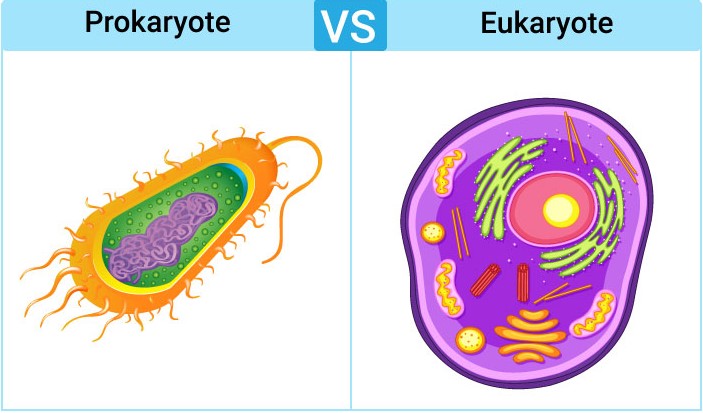Understanding Prokaryotes and Eukaryotes
Prokaryotes and eukaryotes are the two fundamental categories of cellular life on Earth. While both are essential to life as we know it, they differ significantly in structure, function, and evolutionary history. In this article, we’ll delve into the distinctions and characteristics of prokaryotic and eukaryotic cells, laying a foundation for understanding their unique roles in biology.
What Are Prokaryotes?
Definition of Prokaryotes
Prokaryotes are single-celled organisms that lack a membrane-bound nucleus and other organelles. The term “prokaryote” is derived from the Greek words pro- (before) and karyon (nucleus), emphasizing their simpler cellular structure compared to eukaryotes.
Characteristics of Prokaryotes
- Size: Prokaryotic cells are typically smaller, ranging from 0.1 to 5 micrometers in diameter.
- Cell Structure: They lack membrane-bound organelles such as a nucleus, mitochondria, or endoplasmic reticulum.
- Genetic Material: Their DNA is circular and located in a region called the nucleoid, not enclosed by a membrane.
- Reproduction: Prokaryotes reproduce asexually through binary fission, a simple and rapid process.
- Cell Wall: Most prokaryotes have a rigid cell wall made of peptidoglycan, providing structural support and protection.
Examples of Prokaryotes
Prokaryotes include bacteria and archaea, which are found in virtually every environment on Earth, from the depths of the oceans to extreme heat or acidity.
What Are Eukaryotes?
Definition of Eukaryotes
Eukaryotes are organisms whose cells contain a nucleus enclosed by a membrane and other specialized organelles. The name “eukaryote” comes from the Greek words eu- (true) and karyon (nucleus), highlighting their more complex cellular organization.
Characteristics of Eukaryotes
- Size: Eukaryotic cells are generally larger, ranging from 10 to 100 micrometers in diameter.
- Cell Structure: They possess membrane-bound organelles, such as the nucleus, mitochondria, Golgi apparatus, and lysosomes.
- Genetic Material: Their DNA is linear and organized into chromosomes within the nucleus.
- Reproduction: Eukaryotes can reproduce both sexually (via meiosis) and asexually (via mitosis).
- Cytoskeleton: Eukaryotic cells have a cytoskeleton, which provides shape and facilitates movement.
Examples of Eukaryotes
Eukaryotes encompass a wide variety of organisms, including animals, plants, fungi, and protists.
Prokaryotes vs. Eukaryotes: Key Differences

1. Cellular Structure
| Feature | Prokaryotes | Eukaryotes |
|---|---|---|
| Nucleus | Absent | Present |
| Organelles | No membrane-bound organelles | Membrane-bound organelles present |
| Size | Smaller (0.1-5 µm) | Larger (10-100 µm) |
| Cell Wall | Present (peptidoglycan) | Present in plants and fungi |
2. Genetic Organization
Prokaryotes have a single, circular chromosome, whereas eukaryotes possess multiple, linear chromosomes contained within a nucleus. This structural difference impacts gene regulation and cellular processes.
3. Reproduction Methods
- Prokaryotes: Binary fission ensures rapid replication.
- Eukaryotes: A more complex cycle involving mitosis or meiosis supports growth and diversity.
The Evolutionary Perspective
How Prokaryotes Shaped Life on Earth
Prokaryotes were the first forms of life to emerge, approximately 3.5 billion years ago. They played a vital role in creating an oxygen-rich atmosphere through photosynthetic bacteria, such as cyanobacteria.
Endosymbiotic Theory
One of the most intriguing connections between prokaryotes and eukaryotes is the endosymbiotic theory. This theory suggests that mitochondria and chloroplasts in eukaryotic cells originated from free-living prokaryotes engulfed by a host cell.
Prokaryotes and Eukaryotes in Ecosystems
Prokaryotes in the Environment
Prokaryotes are indispensable in ecosystems. They decompose organic material, fix nitrogen, and perform photosynthesis. Archaea, a subset of prokaryotes, thrive in extreme environments, showcasing life’s adaptability.
Eukaryotes in Ecosystems
Eukaryotes contribute to ecological balance through diverse roles as producers, consumers, and decomposers. Plants (eukaryotes) drive photosynthesis, while animals and fungi play critical roles in nutrient cycling.
Applications of Prokaryotes and Eukaryotes
Prokaryotes in Biotechnology
- Medical Research: Bacteria are used in antibiotics and probiotics.
- Genetic Engineering: Escherichia coli is a model organism for genetic studies.
Eukaryotes in Medicine and Agriculture
- Therapeutics: Yeast (a eukaryote) is key in producing vaccines and bioethanol.
- Crop Improvement: Eukaryotic fungi assist in pest control and soil fertility.
Conclusion: Prokaryotes and Eukaryotes in Harmony
Prokaryotes and eukaryotes, despite their differences, represent the diversity and complexity of life. From the simplicity of bacteria to the intricate systems of eukaryotic cells, both are indispensable in maintaining ecological and biological balance.
Stay tuned for Prokaryotes and Eukaryotes – Part 2, where we’ll explore their cellular processes, adaptations, and roles in greater depth.
This article is optimized for the keyword “Prokaryotes and Eukaryotes” and structured for search engine visibility.
Xem thêm video tại:
https://www.youtube.com/@learnabcacademy
Trang chủ LearnABC Education:
https://learnabcacademy.com/
Theo dõi thêm các bài viết tại:
https://huynhtrunutrition.com/
Hãy học cách phòng ngừa thay vì bệnh rồi mới tìm cách chữa trị. Tham khảo 2 tập của sách Ayurveda, link mua sách tại:
http://huynhtruayurveda.com







